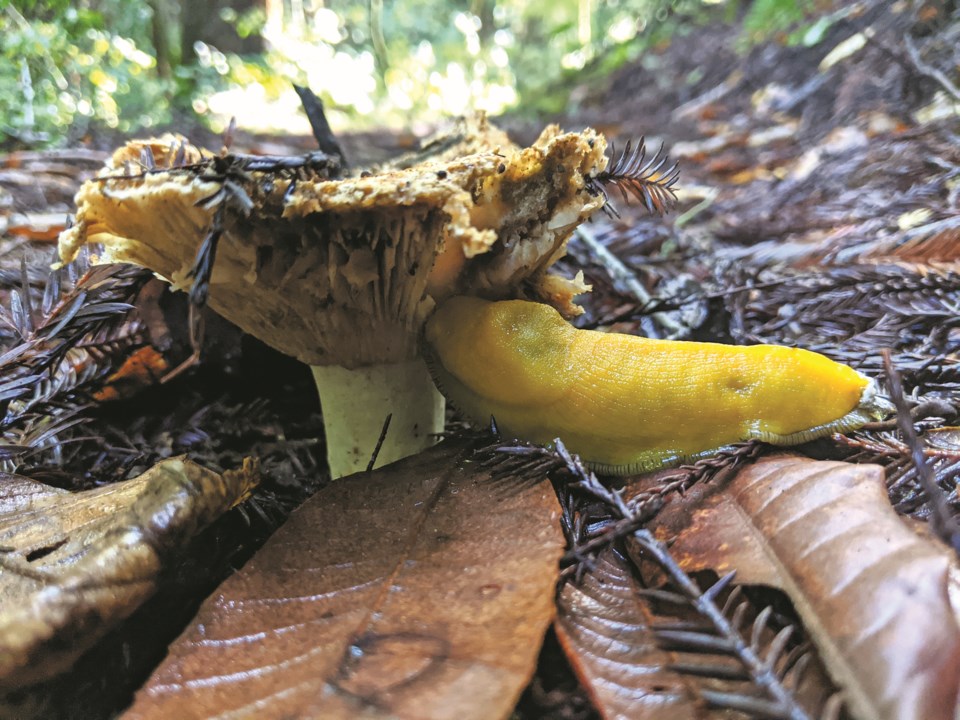In the heart of Whistler’s ancient forests, where the air is thick with the loamy scent of resinous twigs and damp ferns, I dwell—small and unseen, a rove beetle (genus Staphylinidae). I was about to sink my mandibles into the soft, spongy flesh of the delectable Ganoderma polypore (a.k.a. Artist’s Bracket or Reishi) mushroom—when it happened. Suddenly, my world was uprooted—literally. With a flash, a hand equipped with a curved knife sliced my resting spot from the earth. As the ground fell away, I was forced to leap. I landed with a soft thud in the moss, just in time to see the mushroom, once seamlessly attached to an ancient Douglas fir, along with every other mushroom around me, disappear into the forager’s basket. Now, scuffling across the forest floor, I wonder, will there be any place left to hide?
From fungal hyphae to mature mushrooms, insects use various fungal species throughout their lifecycle. “Fungi are an important food source for insects since they accumulate high amounts of nitrogen, phosphorus, and organic compounds such as chitin” (Stefani et al., 2016). These nutrients are vital for growth, development, and reproduction. Some insects, like beetles and ants, actively cultivate or harvest fungi, while others, such as flies and moths, lay their eggs in fungi, providing their larvae with an immediate, nutrient-rich food supply upon hatching.
In a nearby valley, I make my way back to one of my hidden and reliable spots deep in the forest where mushrooms grow in abundance, where I, a mule deer, spend time in order to build up my fat stores before winter’s dawn. But this year, when I arrive, the earth is bare. The mushrooms, usually sprouting in clusters, are all gone, picked clean by unseen hands. My heart sinks as I paw at the empty ground, knowing the cold days are coming fast. Where will I find the food I need to survive the long, bitter months ahead?
Nibbled mushrooms may induce grumbles of frustration from foragers looking for a clean cap, but little teeth marks are a good reminder we aren’t the only ones who love consuming fungi. For herbivores, like our local deer, “mushrooms are generally a good source of proteins and are highly digestible,” and contain various nutrients and vitamins, which make them a high-quality resource (Cadotte et al., 2021).
Besides rove beetles and mule deer, birds like the grouse, various squirrels, and rodents, as well as slugs, snails, and a wide variety of insect species, all incorporate mushrooms into their diverse diets during their yearly woodland routines. Since mushrooms are the fruiting body of the fungi, many will return the following year, depending on the species and favourable environmental conditions. When a mushroom reaches maturity, it spreads spores, microscopic “seeds,” primarily via wind dispersal, so consider your impact if plucking immature mushrooms from the ground. Mushrooms, like other fellow native plants, provide renewable and sustainable food sources. So what four- or six-legged forest friend will you be considerate of when foraging mushrooms this year?
Learn about our local and diverse mushrooms at the 2024 Fungus Among Us Mushroom Festival on Oct. 18 and 19. Tickets will be available at whistlernaturalists.ca.
Naturespeak is prepared by the Whistler Naturalists. To learn more about Whistler’s natural world, go to whistlernaturalists.ca.




